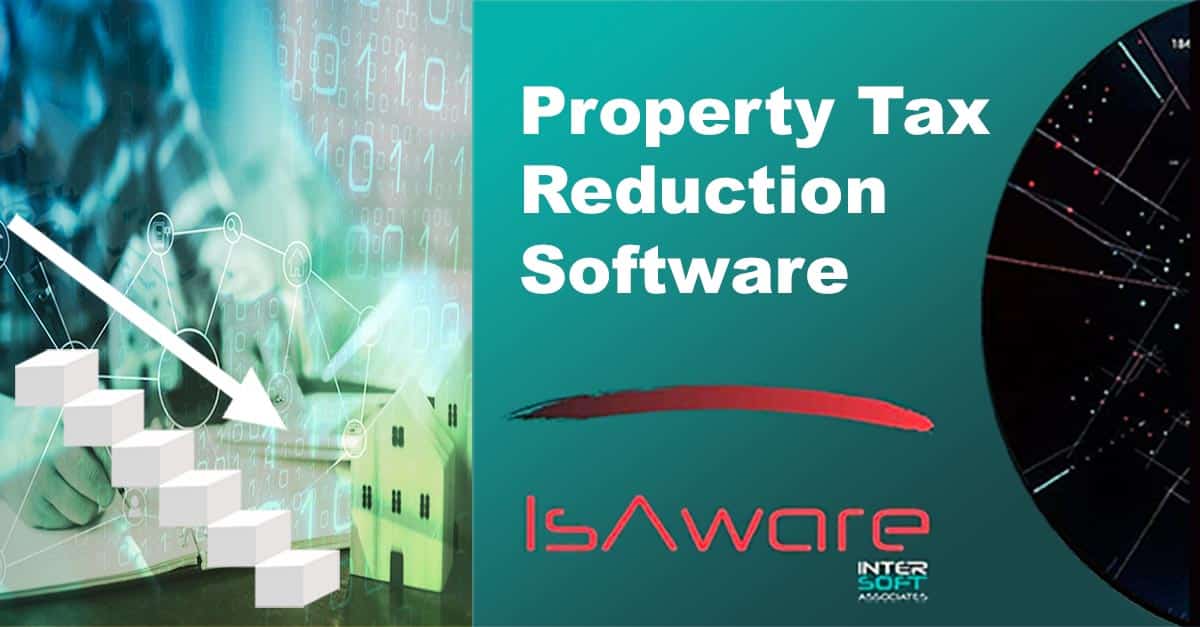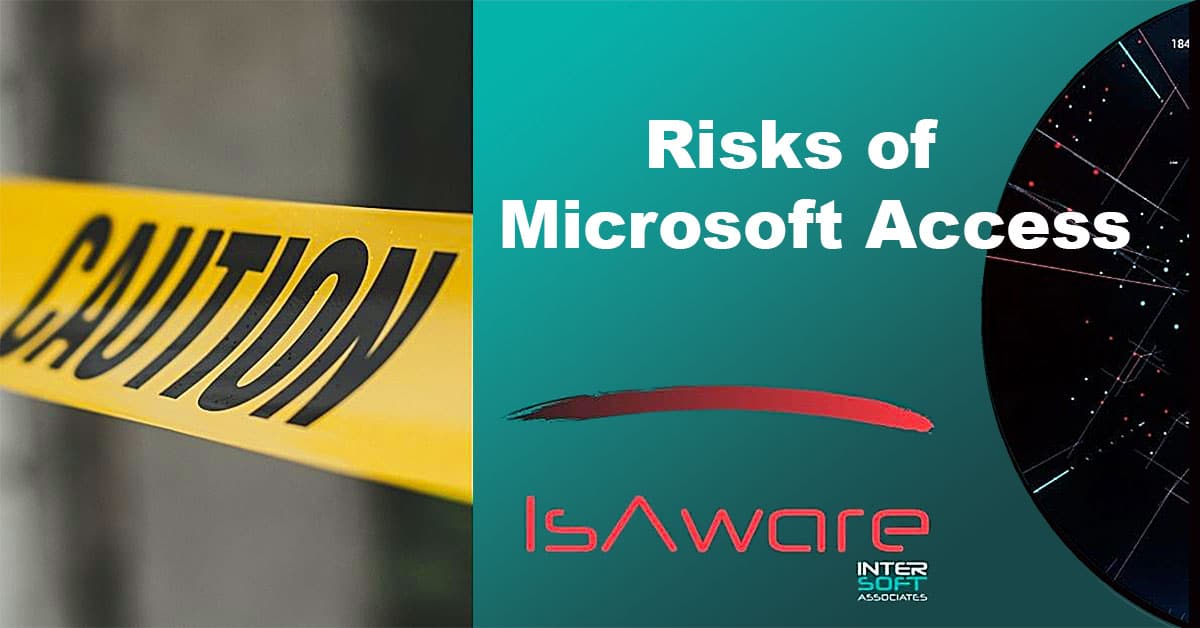This is COBOL
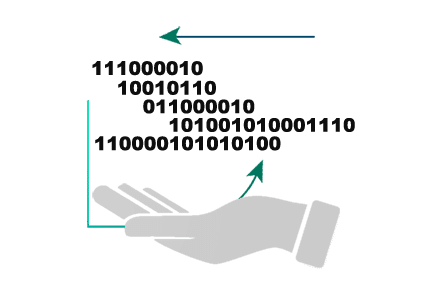
COBOL was developed in response to the increasing demand for a standardized, high-level programming language suitable for use across diverse computing machines. Few programming languages have left such a lasting a mark as the Common Business-Oriented Language known as COBOL.
COBOL : Common Business-Oriented Language : Background & Legacy
This is COBOL: COmmon Business-Oriented Language
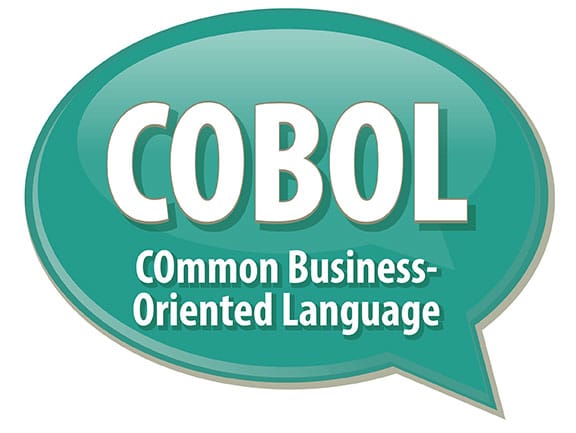
In the annals of computing history, few languages have had as enduring an impact as the Common Business-Oriented Language (COBOL). Conceived in 1959, COBOL revolutionized the way businesses approached data processing. Its development, spearheaded by the visionary computer scientist Grace Hopper and backed by the U.S. Department of Defense, marked a significant leap in programming language design. COBOL’s human-readable syntax, designed to be understood by even those without a deep background in computer science, made it a popular choice for government and business applications. Its introduction coincided with a period of rapid technological advancement and economic growth, positioning COBOL at the heart of the burgeoning data processing industry.
The Birth and Evolution
The creation of COBOL was a response to the growing need for a standardized, high-level programming language that could be used across different machines. Before COBOL, programming was done in machine language or assembly language, which were both highly specific to the hardware they were run on. This lack of portability was a major hindrance to the development of large-scale business applications. COBOL’s development aimed to address these challenges by providing a language that was machine-independent and easy to use.
Code Based on English
The Legacy of Grace Hopper and Early Developments
Grace Hopper (1906-1992) left an indelible mark as a computer pioneer and naval officer. Holding a master’s degree (1930) and a Ph.D. (1934) in mathematics from Yale, her groundbreaking contributions spanned computer programming, software development, and the design of programming languages. Known for her maverick spirit, Hopper enjoyed influential careers in both the U.S. Navy and the computer industry.
Taking a leave from Vassar College where she was teaching, Hopper joined the United States Naval Reserve Women’s Reserve.. Graduating first in her class from the Naval Reserve Midshipmen’s School, she became a junior grade lieutenant assigned to the Bureau of Ships Computation Project at Harvard University.
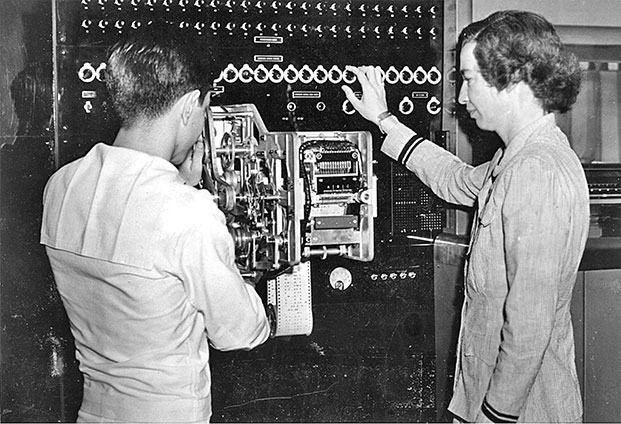
Collaborating with computer pioneer Howard Aiken, Hopper played a key role in developing the Mark I computer, the Automatic Sequence Controlled Calculator. Tasked with programming the Mark I, she authored a comprehensive 500+ page user manual for this early electromechanical computer. Their computations proved vital to the war effort, used for tasks such as calculating rocket trajectories and calibrating minesweepers.
Following her work at Harvard, Hopper joined the Eckert-Mauchly Computer Corporation. As a senior mathematician, she contributed to the development of UNIVAC I, the first large-scale, all-electronic computer that hit the market in 1950. During this time, Hopper proposed a revolutionary idea for a new computer language using English words, leading to the creation of the first computer language compiler.
In 1952, the A-0 program was born, functioning as a linker and enabling programmers to write for multiple computers. Flow-Matic, a compiler-based programming language utilizing English statements, emerged between 1954 and 1955. Released to the public in 1958, Flow-Matic laid the foundation for COBOL, a Common Business-Oriented Language.
Hopper’s vision of word-based languages aimed to make computers accessible to a broader audience, especially those without an engineering or math background. In her pursuit of user-friendly languages, she explained in a 1980 interview, “What I was after in beginning English language [programming] was to bring another whole group of people able to use the computer easily.”
Recognizing the need for a standardized business language, Hopper participated in the 1959 Conference on Data Systems Languages (CODASYL), contributing to the development of COBOL. Widely acknowledged for her role in designing COBOL, developing compilers, and advocating its adoption, Hopper played a pivotal role in making COBOL the most extensively used computer language worldwide by the 1970s.
Read more about Rear Admiral Grace Murray Hopper: The Mother of Cobol
Grace Hopper’s contribution to COBOL cannot be overstated. Her vision for a language based on English words rather than symbolic code was revolutionary. This approach made programming more accessible, allowing more people to contribute to the field of computing. The development of COBOL was a collaborative effort, involving experts from various industries and academia. This collaboration was crucial in ensuring that COBOL met the diverse needs of the business and government sectors.
The Structure and Syntax
COBOL’s syntax is unique in its verbosity, which was intended to make the code self-documenting and easily readable. The language’s divisions and sections provide a clear structure, guiding the programmer through the process of writing comprehensive and efficient programs. The Data Division, in particular, allows for detailed and complex data structures, a feature that has made COBOL particularly effective for business applications involving large-scale data processing.
Let’s compare the ENIAC assembly code for a simple addition task with a hypothetical equivalent written in COBOL.
ENIAC (Electronic Numerical Integrator and Computer) was one of the earliest electronic general-purpose computers developed in the 1940s. ENIAC used a decimal-based machine language.
Please note that COBOL is a high-level language designed for business applications, and the examples might not be directly equivalent due to the abstraction provided by COBOL.
ENIAC Assembly Code (Addition)
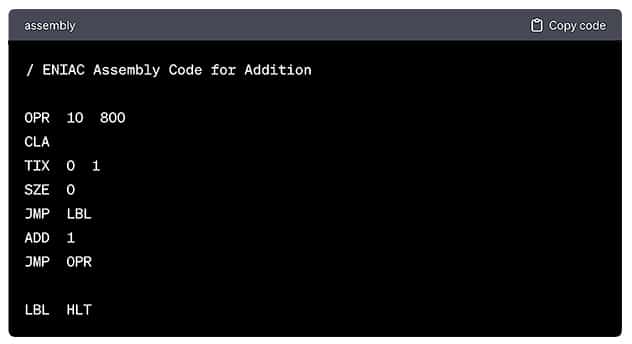
In the ENIAC assembly code, one must manually set up accumulators, perform addition in a loop, and use jumps to control the flow.
Hypothetical COBOL Code for Addition:
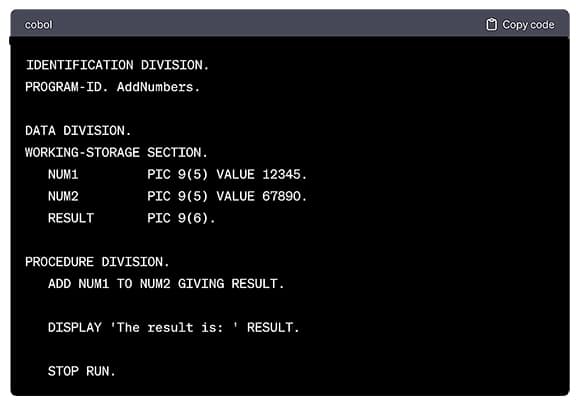
In the COBOL code, we declare variables (NUM1, NUM2, RESULT) with data types, and then simply use the ADD statement to add NUM1 to NUM2, with the result stored in RESULT. The DISPLAY statement is used to output the result.
COBOL abstracts away low-level details and provides a more English-like syntax, making it easier to understand for non-programmers. It focuses on business-oriented tasks and data processing, which is a departure from the low-level, machine-specific nature of ENIAC assembly code.
Technical Aspects
At its core, COBOL is known for its English-like syntax and readable code. This design philosophy stems from the desire to create a language that could be easily read and understood by managers and other non-technical staff. COBOL’s structure is divided into four key divisions: Identification, Environment, Data, and Procedure, each serving a distinct purpose in the program.
A division is a block of code, which usually contains one or more sections. The code starts where the division name is encountered and ends with the beginning of the next division.
The Identification Division is where the program is named.
The Environment Division specifies the hardware where the program will run.
The Data Division defines all the variables and data structures.
The Procedure Division contains the actual code that performs the program’s operations.
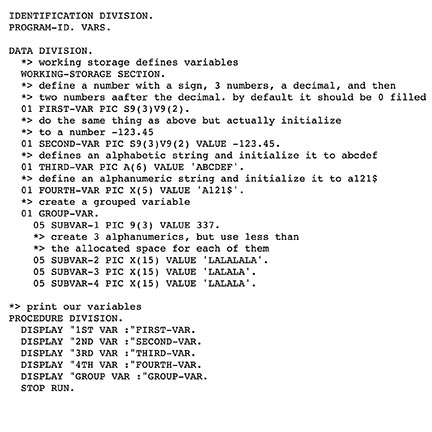
Other components of the COBOL program include:
Sections which are the logical subdivision of the program logic. It is the collection of paragraphs.
Paragraphs which are the portion of a selection which is a user-defined or predefined name which should be followed by a period. This section includes zero or more sentences.
Sentences which are a combination of single or multiple statements. They should occur only in the procedure division. A sentence in COBOL language must end with a period.
Statements are the meaningful COBOL statements which perform some processing.
Characters are the lowest in this COBOL hierarchy and cannot be divided.
For more info on COBOL Programing Structures.
https://www.tutorialandexample.com/cobol-programing-structures
COBOL’s ability to handle vast databases and complex file structures made it a favorite in large organizations where data processing was crucial. Over the years, the language has evolved to include new features and capabilities, keeping pace with changing technological trends. Notably, the introduction of object-oriented features in later versions of COBOL brought a new level of sophistication to the language.
Dominance in Business and Industry
By the 1970s, COBOL had become the most widely used programming language in the world. Its dominance in the business sector was unrivaled, with estimates suggesting that COBOL programs were responsible for the majority of business transactions processed globally. Financial institutions, insurance companies, and government agencies heavily relied on COBOL for their daily operations, making it an essential tool in the world of business computing.

Challenges and Criticisms
Despite its widespread use and success, COBOL has not been without its critics. The language has often been described as outdated, overly verbose, and rigid, particularly when compared to more modern programming languages. One of the major criticisms of COBOL is its perceived inability to adapt to the rapidly changing landscape of technology. Additionally, the dwindling number of programmers skilled in COBOL has raised concerns about the maintenance of existing systems, many of which are critical to the operations of major financial and governmental institutions.
Modernization Efforts and COBOL’s Future
In response to these challenges, there have been significant efforts to modernize COBOL systems. These efforts typically involve integrating COBOL with modern languages and technologies, breathing new life into legacy systems. The open source community has played a crucial role in these modernization efforts, providing tools and support for COBOL programmers.
As we look to the future, it’s clear that COBOL will continue to play a significant role in the world of enterprise computing. While newer languages may offer more features or be more in vogue, the reliability, and efficiency of COBOL, particularly in handling large-scale data processing tasks, ensure its ongoing relevance.
Adaptability and Persistence
As the digital landscape evolved, so did COBOL. Despite predictions of its decline, COBOL has proven remarkably adaptable. Its presence in critical systems, from banking to airline reservations, means that COBOL continues to be a vital part of the global economy. The language’s adaptability is evident in its integration with modern technologies like SQL and XML, as well as its ability to run on contemporary platforms ranging from mainframes to cloud-based systems.

The Challenge of Legacy Systems and Workforce Skills Gap
One of the significant challenges facing COBOL today is the aging of its workforce. As older programmers retire, there is a growing need for new talent skilled in COBOL. However, many computer science programs have shifted their focus to newer languages, leading to a skills gap. This gap poses a risk to the maintenance and updating of critical systems that rely on COBOL.
Bridging the Gap: Education and Modernization Initiatives
In response to the skills gap, there have been initiatives to introduce COBOL into modern computer science curricula. Additionally, tools and platforms have been developed to facilitate the integration of COBOL with modern programming languages and environments. These efforts aim to bridge the gap between the old and the new, ensuring that COBOL continues to function effectively in today’s technological landscape.
COBOL and the Future of Computing
The future of COBOL is one of coexistence with modern technologies. As businesses and governments continue to rely on legacy systems, the need for COBOL and its integration with new technologies becomes increasingly important. The language’s ability to evolve and adapt, coupled with initiatives to educate new programmers, suggests that COBOL will remain a critical tool in the world of business computing for the foreseeable future.
COBOL’s Legacy
COBOL’s legacy is a testament to the foresight of its creators and the adaptability of its design. More than just a programming language, COBOL represents a foundational element in the evolution of business computing. In an age where technological obsolescence occurs rapidly, COBOL’s continued relevance is a remarkable achievement. It stands not only as a crucial tool in many organizations but also as a symbol of the enduring importance of reliable, efficient data processing in the business world.
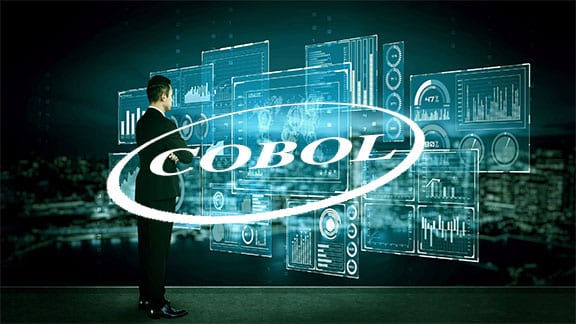
Going Forward
COBOL’s role in shaping the future of computing is undeniable. Its ability to adapt, its compatibility with modern technologies, and its enduring importance in critical sectors make it a language that cannot be overlooked. As we embrace the challenges and opportunities of the digital age, COBOL’s legacy and ongoing evolution remind us of the enduring value of robust, reliable, and efficient computing solutions.
Despite the challenges associated with legacy software, there is renewed interest in COBOL, especially in the context of modernizing legacy systems. Many organizations have begun exploring ways to integrate COBOL applications with modern technologies, including cloud computing and web services. This integration allows for the preservation of reliable COBOL applications while leveraging the benefits of modern technology stacks.
The open source community has played a significant role in this modernization effort. Tools and frameworks have been developed to facilitate the integration of COBOL with new technologies. Additionally, educational initiatives are emerging to train new generations of programmers in COBOL, ensuring that the expertise to maintain and develop these critical systems continues to exist.
The future of COBOL, while uncertain, seems to be secure for the foreseeable future. Its presence in critical systems across various industries ensures that it will continue to be a vital part of the computing landscape. Furthermore, as discussions around the preservation and modernization of legacy systems become more prevalent, COBOL’s role in these conversations is only likely to increase.
COBOL’s journey from a simple business language to a mainstay in critical systems worldwide is a testament to its design and reliability. Its adaptability over the years, despite challenges, highlights the language’s inherent strengths. As the world continues to evolve technologically, COBOL’s legacy remains not only as a piece of computing history but as a living language, continuing to adapt and serve the needs of modern business and government operations. COBOL’s story is far from over, and its contributions to the computing world will continue to be recognized and valued for years to come. However, the transition from outdated COBOL systems to modernized platforms opens avenues for innovation and InterSoftAssociates.com plays a pivotal role in COBOL replacement with custom software.
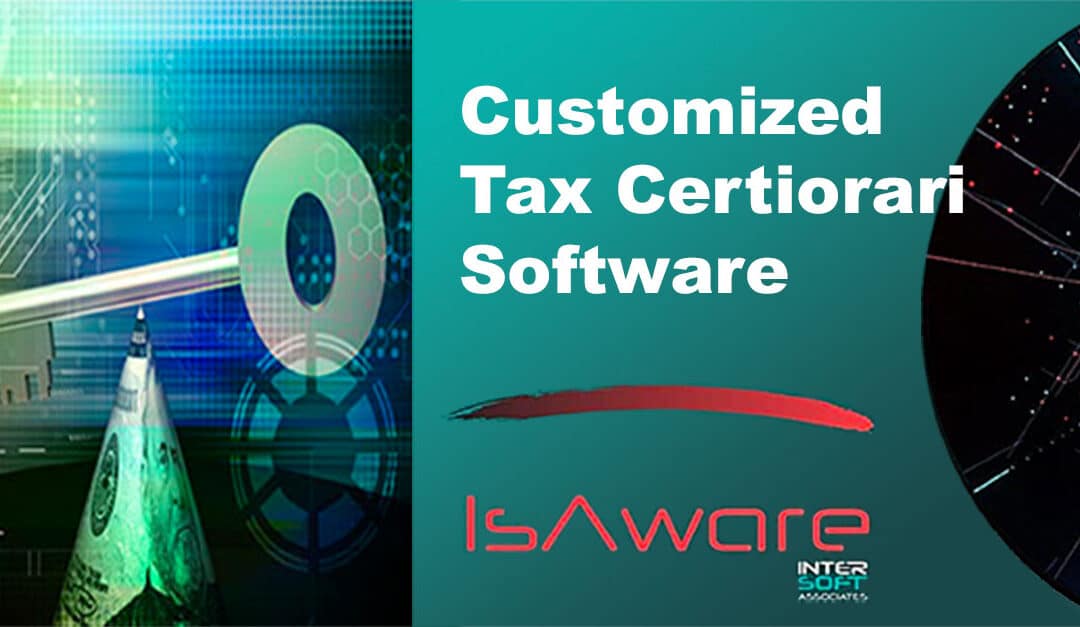
Tax Certiorari Software
The Benefits of Customized Tax Certiorari Software Real estate Tax certiorari is the legal process by which a...

The Risks of Using Microsoft Access
Microsoft Access debuted in 1992 as part of the Microsoft Office suite of office productivity software. It is a...

The Risks of Using Visual FoxPro
Microsoft Visual FoxPro is a discontinued 32-bit architecture-based relational database management system (RDBMS), and...




Software solutions from InterSoft Associates will fit your company exactly and our success rate ensures that it will meet or exceed your expectations.
Download 8 Critical Questions to Ask a Custom Software Developer and avoid common (and expensive!) mistakes.
Before you hire a custom software developer, learn what to ask and what to watch out for!8 Critical Questions to Ask
